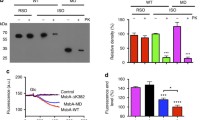Abstract.
The extraordinarily low substrate specificity of P-glycoprotein conflicts with the notion that specific substrate interactions are required in the control of the reaction path in an active transport system. The difficulty is shown to be overcome by a half-coupled mechanism in which the ATP reaction is linked to carrier transformations, as in a fully coupled system, but in which the transported substrate plays a passive role. The mechanism, which requires no specific interaction with the substrate, brings about uphill transport. A half-coupled mechanism is directly supported by two observations: (i) almost completely uncoupled ATPase activity in purified P-glycoprotein, and (ii) a pattern of substrate specificity like that of passive systems, where maximum rates for different substrates vary little (unlike active systems, where maximum rates vary greatly). The mechanism accommodates other findings: partial inhibition of ATPase activity by an actively transported substrate; simultaneous binding and translocation of more than one substrate molecule; and stimulation or inhibition of the transport of one substrate molecule by another. A half-coupled system associated with an internal competitive inhibitor should behave as if tightly coupled, in agreement with the effects of the synthetic peptide, polytryptophan. The degree of coupling in the intact system is yet to be determined, however. A half-coupled ATPase mechanism could originally have evolved in a flippase, where immersion of the carrier in its substrate, the membrane lipid, precludes uncoupled ATP hydrolysis. These concepts may have wider application. An uncoupled antiport mechanism, driven by a proton gradient rather than ATP, can explain low selectivity in the SMR multidrug carriers of bacteria, and a half-coupled mechanism for the ion-driven cotransport of water (the substrate in which the carrier site is immersed) can explain a recently proposed uphill flow of water.
Similar content being viewed by others
Author information
Authors and Affiliations
Additional information
Received: 23 April 1999/Revised: 29 July 1999
Rights and permissions
About this article
Cite this article
Krupka, R. Uncoupled Active Transport Mechanisms Accounting for Low Selectivity in Multidrug Carriers: P-Glycoprotein and SMR Antiporters. J. Membrane Biol. 172, 129–143 (1999). https://doi.org/10.1007/s002329900591
Issue Date:
DOI: https://doi.org/10.1007/s002329900591




